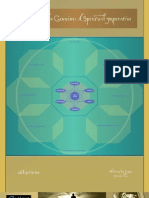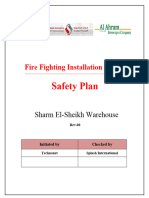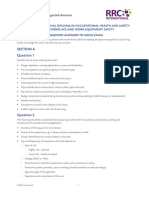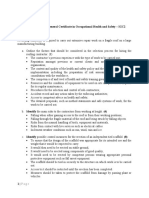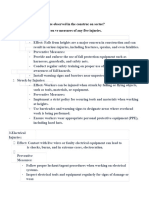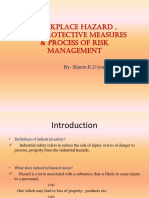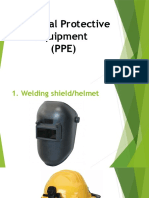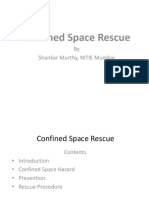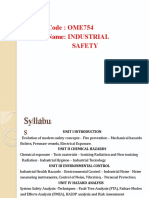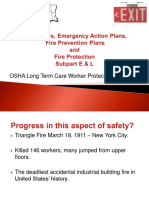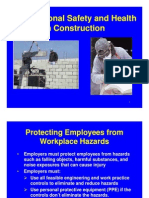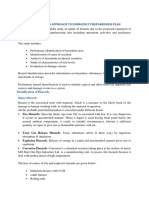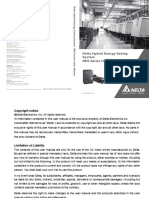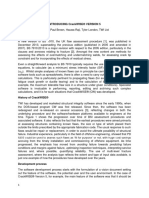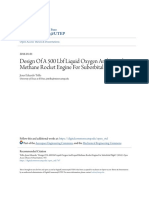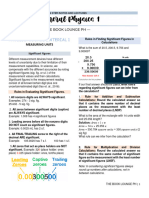0 ratings0% found this document useful (0 votes)
58 viewsExcavation Safety
Excavation Safety
Uploaded by
Farooq SialThe document provides 10 safety tips for excavation work. It recommends inspecting trenches daily, checking weather conditions, keeping heavy equipment away from trench edges, being aware of underground utilities, wearing protective equipment, not working under raised loads, conducting atmosphere tests if toxic gases are detected, using protective systems like benching and sloping, having a competent person plan and implement safety measures, and performing regular self-inspections using a checklist.
Copyright:
© All Rights Reserved
Available Formats
Download as DOCX, PDF, TXT or read online from Scribd
Excavation Safety
Excavation Safety
Uploaded by
Farooq Sial0 ratings0% found this document useful (0 votes)
58 views10 pagesThe document provides 10 safety tips for excavation work. It recommends inspecting trenches daily, checking weather conditions, keeping heavy equipment away from trench edges, being aware of underground utilities, wearing protective equipment, not working under raised loads, conducting atmosphere tests if toxic gases are detected, using protective systems like benching and sloping, having a competent person plan and implement safety measures, and performing regular self-inspections using a checklist.
Original Description:
excavation safety
Original Title
excavation safety
Copyright
© © All Rights Reserved
Available Formats
DOCX, PDF, TXT or read online from Scribd
Share this document
Did you find this document useful?
Is this content inappropriate?
The document provides 10 safety tips for excavation work. It recommends inspecting trenches daily, checking weather conditions, keeping heavy equipment away from trench edges, being aware of underground utilities, wearing protective equipment, not working under raised loads, conducting atmosphere tests if toxic gases are detected, using protective systems like benching and sloping, having a competent person plan and implement safety measures, and performing regular self-inspections using a checklist.
Copyright:
© All Rights Reserved
Available Formats
Download as DOCX, PDF, TXT or read online from Scribd
Download as docx, pdf, or txt
0 ratings0% found this document useful (0 votes)
58 views10 pagesExcavation Safety
Excavation Safety
Uploaded by
Farooq SialThe document provides 10 safety tips for excavation work. It recommends inspecting trenches daily, checking weather conditions, keeping heavy equipment away from trench edges, being aware of underground utilities, wearing protective equipment, not working under raised loads, conducting atmosphere tests if toxic gases are detected, using protective systems like benching and sloping, having a competent person plan and implement safety measures, and performing regular self-inspections using a checklist.
Copyright:
© All Rights Reserved
Available Formats
Download as DOCX, PDF, TXT or read online from Scribd
Download as docx, pdf, or txt
You are on page 1of 10
10 Excavation Safety Tips
To protect workers from injuries and fatalities, preventive measures should be
implemented when workers begin excavating. According to OSHA, general
safety measures to follow should cover the following:
1. Inspect trenches daily before work begins. Don’t go near an unprotected
trench.
2. Check weather conditions before work, be mindful of rain and storms.
3. Keep heavy equipment away from trench edges.
4. Be mindful of the location of utilities underground.
5. Always wear proper protective equipment.
6. Don’t work beneath raised loads.
7. Conduct atmosphere tests. If low oxygen and toxic gases were detected,
workers must not enter the trench.
8. Protective systems like benching, sloping, shoring and shielding must be
created.
9. Planning and implementation of safety measures must be done by a
competent person.
10. Use a checklist to perform regular self inspections -
NEBOSH IGC sample Questions & Answer (don't ignore this questions because this questions are most of the time
came on NEBOSH IGC )
Learn (y) & Share
1. Outline the possible effects on workers’ health when exposed to high noise levels
Short-term effects: Acute acoustic trauma: sudden damage of ear drum due to intense noise levels as in explosion.
Temporary threshold shift: due to fatigue of hearing cells conveying frequencies outside the conversation speech
range.
• Long-term effects:
Tinnitus: ringing in the ear due to intense stimulation of auditory nerve over a period of time.
Permanent threshold shift: due to death of hearing cells conveying frequencies outside the conversation speech
range.
Noise-induced hearing loss: due to death of hearing cells conveying conversation speech frequencies.
Fatigue or stress.
2. Outline the factors to be considered when selecting personal hearing protection for workers.
• Type of risk
• The level of protection to be afforded.
• Compliance with standards.
• Ergonomic factors (fit & comfort).
• Compatibility with other equipment.
• Cost.
• Inspection to detect defects.
• Proper storage.
• Replacement of defective equipment.
3. Describe, with practical examples noise control techniques that would reduce noise levels in the workplace.
• Silencing: the use of silencers to suppress noise generated when air, gas, or steam flow in pipes or are exhausted
to atmosphere.
• Isolation: in acoustically-quiet booths.
• Screens: to reduce direct noise transmission.
• Lagging: can be used on pipes carrying steam or hot liquids.
• Process change: e.g.: presses instead of hammers, Bolting instead of riveting.
• Operating rotating and reciprocating equipment as slowly as practicable.
• Keeping sudden velocity changes in pipe work and ducts to a minimum.
• Enclosure: surrounding the noise source with sound absorbing material (the effect is limited until total enclosure is
achieved).
• Equipment design: e.g.: use of nylon gears.
• Proper maintenance & lubrication of machines
4. Identify control measures to reduce the risk of electric shock when using a portable electrical drill (8)
• Proper selection of the equipment "to be suitable for the purpose“.
• Inspection and testing of the equipment.
• The use of reduced voltage or battery-powered equipment.
• Double insulation.
• Earthing.
• Use of protective devices (as RCDs & fuses).Sound connections.
• Proper storage of equipment.
• Training to be given for equipment operators.
5. identify 8 types of mechanical hazards associated with machinery
• Impact. b) Crushing. c) Entanglement. d) Shearing. e) Cutting. f) Friction & Abrasion. g) Stabbing & Puncture. h)
Drawing in J) Ejection
6. identify 4 hazards associated with the use battery-powered fork lift trucks
Electrical hazards:
• Explosion due to contact of live cables with the metal of the truck frame and the shorting of battery terminals by
metal tools or lifting tackle.
• Battery spark leading to ignition of hydrogen "Generated during charging" leading to dangerous explosion.
Non- Electrical hazards:
• Overloading 2) Overturning 3) Collision 4) Loss of Load. 5) Overhead obstruction. 6) Truck failures.
7. Outline control measures for each of the hazards identified in (a)
8. Identify 2 types of hazardous substance
• Asbestos 2) sodium hypochlorite
9. Outline personal hygiene controls to reduce the risk of ingestion of a hazardous substance.
• Regular hand washing
• Restriction of smoking and eating in the workplace
• Removing and cleaning of contaminated clothes
• The use of suitable PPE(as gloves)
10. Identify precautions necessary to prevent injury when working in and around excavation.
• Examine the support structures weekly by competent person
• Record examination
• Inspect working part daily or per shift if deeper than 2m
• Inspect support material before use
• Support work done under supervision of competent person
• No person to work in excavation unless competently examined
• No projecting nails on support structure
• No materials left near edges of excavation
11. Outline the term “repairable dust”
• Is an airborne dust of such a size that is able to enter the lungs during normal respiration. Dust of 5 microns size or
less is respriable.
12. Outline the methods for measuring airborne dust in the workplace
A)Visual signs of dust accumulation. B). Dust lamps. C). Direct reading instruments.
D) Sampling using pumps and filters followed by analysis.
13. identify control measures to reduce the risk of accidents form reversing vehicles in the work place
• Elimination of the risk (redesign task to eliminate the need for vehicles to reverse).
• The availability of banks men to lead the vehicle.
• Good communication between vehicle driver and banks men.
• Marking of the route of vehicles.
• Proper lighting of the area.
• Speed limits within the workplace.
• Proper selection and training of vehicles "Rear view concave mirror".
• Availability of mirrors in the work place especially on the turns and corners,
• Audible and visual alarms (flashing beacons).
• Proper supervision of driver acts.
• Disciplinary action to be taken for any violations of unsafe acts by the drivers.
• Control measures so that to prevent the use of vehicles by unauthorized persons.
14. identify the risk factors that could affect manual handling activities in relation to
a. load b) the individual
Load: weight, size, stability, height, contents, outer surface, lack of rigidity (smoothness), the ease with which it can
be grasped, etc.
Individual: physical capabilities, health (fitness, pregnancy, etc.)
15. identify 3 control measures to segregate pedestrians and vehicles in the workplace
• there are best prevented by completely separating pedestrians and vehicle
• providing well marked , protected and laid out pedestrian walkways
• people should cross roads by designated and clearly marked pedestrian crossings
• suitable guardrails and barriers should be erected at entrance and exits from buildings and at blind corner
• separate doorways are provided for pedestrians and vehicles
• all doorways should be provided with a vision panel and an indication of the safe clearance height
• the enforcement of a sensible speed limit , coupled where practicable with speed governing devices
16. identify measures to reduce the risk to pedestrians when segregation is not practicable
17. identify precautions that would need to be considered before welding work can commence
• approved method statement and risk assessment in place
• ensure all work equipment is in good order
• check location and means of raising alarm
• ensure correct extinguishers to hand
• inspect adjacent areas including above and below
• remove or suitable project combustible material from work area
• ensure area is cordon off and necessary signage displayed
• provision of screens or blankets to protect against spread of sparks and hot particles
• competent person and competent supervision
• permit to work system ( hot work permit )
• first aid facility near the area
• training for the workers
• Adequate PPE (Welding gloves, goggles, welding shield, hard hat, cover all and aprons etc……)
18. Outline control measures to reduce the risks to workers when using- non-powered hand tools
• To wear the suitable Personal Protective Equipments (goggles, gloves, etc)
• To report any defects in the tool
• To be sure that work surface is clean (before using the tool)
• To use the tool by designed safe way
• To clean the tool after use and to keep it in its designed location
19. identify 4 forms for hazardous substance for which respiratory protective equipment could be used to reduce the
risk of harm
dust vapour fume & gas
20. Outline factors that could reduce the effectiveness of the respiratory protective equipment.
21. identify the possible effects of electricity on the body
Primary effects: due to electric shock on the human body
physiology leading to: C) electric burns in skin & internal organs. D)cardiac & respiratory arrest.
Secondary effects: due to fall from a height including
for example:
Fracture, bleeding, etc.
22. identify the emergency action to take if a person suffers a severs electric shock
• Isolation of the electric supply "if possible“
• Removal of the casualty from electric contact (using isolating material).
• Summoning help.
• Cardio pulmonary resuscitation (CPR).
• Treatment of burns and other injuries.
• Remaining with the casualty until medical help arrives.
23. Outline the general role a fire marshal would be expected to undertake in an emergency evacuation of a
workplace in the event of a fire
• to assist the fire safety co-ordinator in fire drills
• on discovering a fire , ensure the fire alarm is sounded , than alert reception or the central point of contact to ensure
the emergency services are called
• on hearing a fire alarm, ensure that the floor is completely evacuated (including checked toilets , storerooms or any
other special areas in your zone of responsibility )and employees and visitors proceed in an orderly manner to the
assembly point
• Remind all persons evacuating the building to use the nearest fire exit and NOT TO USE THE LIFT.
• Only if it is safe to do so , tackle the fire using the appropriate extinguisher but DO NOT take any person risk, the
evacuation of the building is of paramount importance
• Only if it is safe to do so , check and ensure all windows and doors are closed to limit firer spread
• Once outside at the assembly point , remind your charges not to re-enter the building contact the
office/establishment fire co-ordinator to advise that all occupants have been evacuated and give any further relevant
information on the status of the fire .
24. Identify safe working practices for the use of a mobile elevating working platform (MEWP)
• the need to inspect the equipment before use and to ensure it is in a good state of repair;
• using only competent workers;
• using outriggers and brakes;
• erecting warning signs and barriers to avoid collisions;
• ensuring the platform is not overloaded;
• avoiding overhead obstructions; and
• wearing a harness.
25. Describe the possible effects on hearing from exposure to noise
26. Outline the factors that are likely to affect the performance of personal hearing protection
27. Three meter deep trench has to be dug across a car park
28. Identify hazards associated with the work (10)
• Detection of services (from plans, use of cable/pipe detectors).
• Support of sides.
• Storage of materials and take it away from edge.
• Stop blocks to prevent vehicles from falling into excavation.
• Barriers and guard rails.
• Safe means of access/egress.
• Testing for and ventilation of fumes.
• Means of pumping out water.
• Competent personnel.
• Use of suitable PPE.
29. Outline precautions that should be taken when using a mobile crane
• The crane must be suitable (test certificate, reach, lifting capacity, etc.)
• The crane is to be used on stable and level base
• Outriggers should be used effectively and correctly "to be fully extended and locked on all sides"
• Avoid obstructions/overhead lines.
• The height limit structure should be erected, decked with warning flags.
• Suitable lifting
• Correct slinging techniques.
• Ensuring competence of personnel (driver, slinger, and signaler).
• Ensuring good visibility & communication.
30. a portable electric drill is being used on a building site other than electricity identify 4 hazards associated with the
use of the drill
• Dust hazards.
• Noise hazards.
• Vibration hazards.
• Tripping due to trailing cables.
• Ergonomic hazard (related either to equipment design or to the way in which the work is carried out).
b.Outline 4 precautions that could be taken to reduce the risk to workers.
31. Outline control measures to reduce the risks to workers when using non-powered hand tools
• To wear the suitable Personal Protective Equipments (goggles, gloves, etc)
• To report any defects in the tool
• To be sure that work surface is clean (before using the tool)
• To use the tool by designed safe way
• To clean the tool after use and to keep it in its designed location
32. a) Identify FOUR forms of hazardous substance for which respiratory protective equipment could be used to
reduce the risk of harm
dust vapour fume & gas
b) Outline factors that could reduce the effectiveness if of the respiratory protective equipment
33. a) Describe the possible effect on hearing from exposure to noise
Short-term effects: Acute acoustic trauma: sudden damage of ear drum due to intense noise levels as in explosion.
Temporary threshold shift: due to fatigue of hearing cells conveying frequencies outside the conversation speech
range.
• Long-term effects:
Tinnitus: ringing in the ear due to intense stimulation of auditory nerve over a period of time.
Permanent threshold shift: due to death of hearing cells conveying frequencies outside the conversation speech
range.
Noise-induced hearing loss: due to death of hearing cells conveying conversation speech frequencies.
Fatigue & stress
b) Outline the factors that likely to affect the performance of
Personal hearing protection
34. Battery – powered fork –lift trucks are used to move materials in a warehouse.
a) Identify FOUR hazards associated specifically with battery-powered fork-lift trucks.
b) Identify precaution that may be needed to reduce the risk to pedestrian in areas where the fork-lift trucks are
operating.
c) precautions that should be taken when leaving a fork-lift unattended.
• To be left on a firm level ground in a designated area with the mast tilted slightly forward and the forks resting on the
floor.
• The truck is to be switched off.
• The key to be removed and to be given to a responsible person (to prevent unauthorized use of the truck).
• The truck should not be left until the brake has been applied.
• To be parked away from other vehicles.
• To be parked away from adverse environmental conditions as rains.
• To be parked in a positions that does not obstruct emergency exits / vehicles, walkways, etc.
• Keeping regular maintenance of the truck even if not attended.
• If the truck is to be left unattended for a long period, it may be useful to:
-Isolate electricity if the truck if it is electrically operated.
-Remove the battery (if it is battery operated).
-Remove LPG cylinder (if it is gas operated).
35. Identify precaution that should be considered to prevent accidents to children who may be tempted to gain access
to a construction site.
• Fencing
• Warning signs of any dangers
• Security patrols
• CCTV
• Isolating services
• Reducing heights of materials
• Covering excavations
• Removing ladders – lashing the ladders – to deny access to scaffolding
• Securing tools, chemicals, equipment and vehicles under lock and key
• Community liaisons
36. Outline FOUR main categories of guards and safeguarding devices that may be used to minimize the risk of
contact with dangerous parts of machinery
• FIXED GUARD - Is a physical barrier that prevent access to danger area..
• Is not connected to machine controls.
• With no moving parts.
• Is so fixed that it requires a special tool (e.g. spanner) to remove it.
•
INTERLOCK GUARD
• Is linked with machine controls such that the guard cannot be opened if the machine is in a dangerous condition or
opening the guard cause the machine to become safe.
• SELF-ADJUSTING GUARD
• Is essentially a fixed guard that has elements that can be adjusted to allow for the material being processed.
• Typical examples can be found on circular saws & drill chucks.
• TRIP DEVICE
• Is a guard which stops or reverse the machine before the operator reaches the hazard area
• Ex photoelectric guard used for hyrulic presses
• AUTIMATIC GUARD
• Is linked to the machine mechanism & physically moves an operator from the danger zone.
37. a) Identify THREE forms of biological agents
b) Identify THREE possible routes of entry into body for a biological agent.
• Inhalation.
• Ingestion.
• Injection.
• Entry through open wounds.
c) Give TWO control measures to reduce the risk of exposure to a biological
agent.
• Disinfection for materials or equipment contaminated with the agent.
• Good personal hygiene.
• Immunization: vaccination.
• Water control (by boiling or chlorination).
• Proper disposal of wastes.
• Use of the appropriate PPE.
38. Identify the information that should be included on a manufacture’s safety data sheet supplied with a hazardous
substance
• The name of the substance.
• It's physical and chemical properties.
• Substance concentration.
• The nature of hazard caused by the substance.
• Relevant standards related to the substance (e.g.: OES).
• Precautions to be taken in storage, transport, use & disposal of the substance.
• Measures to be taken in cases of emergency (e.g.: spillage or accident exposure) including first aid measures.
• PPE recommended to be worn on dealing with the substance.
39. A worker is manually loading boxes of components onto metal shelves
a) Identify FOUR types of injury that the worker could suffer while carrying out this task
• Examples of injuries are:
Cuts, abrasion.
Crushing injuries.
Strained ligaments and tendons.
Dislocations of joints.
Hernias
Bone fractures
b) Identify factors in relation to the task that could increase the risk of injury. (4)
• Task factors that may affect the risk of injury:
Handling loads at a distance from the body.
Excessive carrying, lifting or lowering distances.
Excessive pushing or pulling.
Pushing or pulling loads above or below waist level.
The need to lift from and to return loads to the ground level.
Task requiring stooping, twisting or overreaching.
Task requiring repetitive handling with no sufficient rest periods.
40. Identify the principles of the fire triangle
Fuel, heat & oxygen
41. Identify THREE methods of heat transfer and state how EACH contributes to the spread of fire
i) conduction, ii) convection iii) radiation iv) direct burning.
• heat can be transferred through metal beams or other parts of a structure by conduction;
• it can be carried by rising air currents (convection) to cause a build-up of hot gases under ceilings;
• it can be radiated through the air causing heating of material at a distance from a fire; and,
• combustible material in direct contact with flames can itself catch fire.
•
42. Identify FOUR types of engineering control that may be used to reduce noise in the workplace and give a
practical example of each.
• Absorption: using barriers of porous material (e.g.: foam) to reduce sound energy, e.g.: baffles.
• Damping: the use of rubber, cork, or similar material to reduce structure borne noise (these materials are to be fitted
as pads, stiffening ribs, etc. to reduce vibration) e.g.: machines mounts.
• Silencing: the use of silencers to suppress noise generated when air, gas, or steam flow in pipes or are exhausted
to atmosphere.
• Isolation: in acoustically-quiet booths.
• Screens: to reduce direct noise transmission.
Lagging: can be used on pipes carrying steam or hot liquids
43. a) identify FOUR types of ionizing radiation
Workplace sources of ionizing radiation:
• Medical x-ray equipment.
• Smoke detectors.
• X-ray for scrutiny of welds
• ALPHA OR BETA RADIATION
• GAMMA RADIATION
b) Outline the main control measures for ionizing radiation
• Reducing time of exposure to ionizing radiation.
• Shielding (interposing material between radiation source and exposed person): materials of high mass number are
chosen for shielding.
• Distance: increasing the distance between radiation source & those exposed will reduce the radiation dose
received.
Reducing time of exposure to ionizing radiation.
Shielding (interposing material between radiation source and exposed person): materials of high mass number are
chosen for shielding.
Distance: increasing the distance between radiation source & those exposed will reduce the radiation dose received.
• Proper disposal of radioactive wastes.
• Wearing the suitable PPE: to prevent radioactive material from being inhaled, ingested or coming into contact with
skin.
• Warning signs to refer to Radiation hazard.
44. Identify the main hazards that may be present during the demolition of a building.
The main hazards associated with this type of work include: falls from a height; falling debris and premature collapse;
use of explosives; contact with and noise from equipment and heavy plant; dust (possibly including asbestos); hot
work from metal¬cutting operations; the presence of hazardous materials from previous uses of the building; the
presence of cellars or vaults affecting the stability of adjoining premises; and the possible presence of services such
as electricity, gas and water.
45. an organization uses small quantities of toxic chemicls.
a) Identify FOUR possible routes of entry of toxic substance into the body
By inhalation: if the chemicals agents is in the form of dust, vapour, fume, gas, etc. it is the most rapid route of
entrance.
By contact with the skin: chemicals can either: 1)Irritate the skin causing dermatitis.2)Penetrate the skin causing
systemic toxicity.
3)Damage the skin directly (such as acid)
By ingestion: can occur directly (by mistake if chemicals are not properly labeled) or indirectly through hands
contaminated with chemicals and reaching the mouth during eating, drinking or smoking.
Injection: chemicals may injected hypodermically on sharps etc. or they may be injected at high pressure e.g form
hydraulic hoses.
b) Explain the difference between acute and chronic health effect
Acute health effect: an adverse effect resulting from a single or short-term exposure and producing an immediate or
rapid effect. Examples: corrosive action, narcosis and primary irritation.
acute health effects appear after a single or short term exposure, usually with a rapid or immediate
response, whereas
• chronic effects are normally produced following prolonged or repeated exposures to an agent,
appear gradually, may go unrecognised for long periods of time and may be progressive even
without further exposure.
c) Identify the sources of information which could be used in the assessment of risk of toxic substances
d) Outline the control measures that might be required in order to minimize risks to workers
The use of suitable container for the chemical and the methods for handling thm,
The provision of ventilation and appropriate personal protective equipments
Procedure for dealing with spillage
The introduction of site rules to ensure personal hygiene
The provision of information and training to the staff involved
46. Identify the control measures that could be implemented to reduce the risk pedestrians in areas where vehicles
are maneuvering.
• Segregation systems for vehicles and pedestrians
• Clear and appropriate road markings
• Visibility – mirrors, transparent doors, adequate lighting etc.
• Vehicular audible warnings
• Site rules
• High-visibility clothing
• Good housekeeping
• Training and supervision of all involved on site
46. Outline specific hazards associated with the use of battery – powered forklift trucks and state the precautions
necessary in each case
Part (i) related to hazards specific to battery-powered trucks and was not well answered. Many candidates cited
general fork-lift truck hazards and concentrated on overturning issues. The few candidates who recognised that this
question was specific to a particular type of fork-lift truck described hazards relating to battery¬charging (including the
generation of hydrogen gas and release of battery acid), hazards associated with the handling of batteries, electrical
hazards with the potential for electric shock or burns, and collisions with pedestrians due to the near-silent running of
the truck.
In answering part (ii), most candidates referred to precautions such as marking of traffic routes, one-way systems,
segregation of pedestrians from transport, warning signs and audible alarms, and visibility issues such as adequate
lighting, mirrors, high visibility clothing and transparent doors_ Few candidates, however, considered the provision of
safe systems of work for loading, unloading and stacking, the enforcement of site rules on speed restrictions and
access, and the training and supervision of staff.
47. Excavation work is being carried out on a construction site, identify the control measures needed to reduce the
risk to workers.
• Detection of services (from plans, use of cable/pipe detectors).
• Support of sides.
• Storage of materials and take it away from edge.
• Stop blocks to prevent vehicles from falling into excavation.
• Barriers and guard rails.
• Safe means of access/egress.
• Testing for and ventilation of fumes.
• Means of pumping out water.
• Competent personnel.
• Use of suitable PPE.
48. a) Identify FOUR mechanical hazards associated with the use of a pedestal drill.
Entaglement
Ejection
Stabbing
Impact
b) Outline FOUR control measures to reduce the risk of injury to operators of pedestal drills.
Installation of a spindal guards
A safe system of work which is posted close to the machine
Have policy in a place so that users do not have long hair
Rings and other jewellery that could become entangled
Ensure all users are trained and competent in the use of the equipments
49. Outline the factor that may lead to occupational stress amongst workers
In answer to this question, possible causes of increased stress levels could usefully have been divided into those
relating to the work or task organisation and those relating to workplace interactions. Job factors might include: shift-
work or unsocial hours; excessive overtime; job insecurity and the fear of redundancy; repetitive or monotonous work;
lack of adequate breaks; lack of control over the job; work load too high or too low; and the task not matched to the
skills of the person. Interactions involve such issues as harassment, bullying, discrimination, fear of violence, poor
communication and general relationships with work colleagues. There are also a range of personal and social factors,
such as illness, financial worries and family commitments, that could increase an employee's level of stress at work,
even if some may not be work-related.
50. a) Identify FOUR factors that could affect the severity of injury resulting from contact with electricity
For part many answers concentrated almost entirely on the voltages involved. Relatively few candidates outlined
additional factors such as the route taken through the body, the length of contact time, the general health and age of
the person involved, and those factors that might affect the size of current passing through the body. In particular,
there was little understanding of resistance, based on things such as dryness of the skin, natural body resistance,
ground conditions and type of footwear.
51. a)In relation to the classification of fires, give an example of a material (fuel) that falls within each of the classes
A, B, C, AND D.
Fire Type of Fuel
A Solid(as wood,glass,clothes,papers,etc)
B Liquids(as petroleum & paints)
C Gases (as Acetyleum ,Hydrogen sulphide ,Natural Gas)
D Metal(as sodium ,magnesium , Aluminum)
52. Outline the hazards that a worker could be exposed to when using a petrol driven chainsaw to cut down a tree
Contact with moving part of the machine
Expose to fumes & dust
Manual handling hazards
Noise & vibration
Ejected particles
Falling objects(ultimately, the tree itself)
Fire & explosion hazards from the fuel
Hot part of the chainsaw
Uneven or wet ground
The use of lubricants oils & exposure to sunlight
53. A maintenance worker regularly uses a hand held grinder, and is exposed to vibration
a) Identify the symptoms that the worker may experience due to this exposure
i) The typical symptoms are:
• Numbness of fingers.
• Blanching of fingers.
• Swollen painful joints.
• Reduction in manual dexterity (things may fall form hands and fine adjustment by hand cannot be achieved).
b) Outline six control measures that can be used to reduce the risk from vibration
i) The control measures are:
• Eliminate the risk: by process change to eliminate the need for using vibrating hand-held tools.
• Reduce the risk: To modify operating procedure so that the pressure upon the tool required by operator is reduced.
• Proper selection of equipment and maintenance.
• Reducing time of exposure of operators to vibration (this may necessitate recruitment of new staff).
• Health surveillance to detect the early sings and symptoms of vibration illness.
• Use of appropriate PPE (as gloves to keep hand warm).
54. Identify EIGHT common causes of fires in the workplace
55. identify 8 safe working practices that should be considered to reduce the risk when using a mobile tower scaffold.
Precautions for safe use of mobile towers:
• Erection should be in accordance with manufacturer's recommendation.
• Erection, alteration & dismantling to be done by competent persons.
• It should stand on a firm level base.
• Scaffold tubes to be free from defects e.g.: bent sections.
• Proper bracing to prevent twisting and collapse.
• The ratio of the minimum base dimensions to the height should not exceed: 1:3 in external use & 1:3.5 in internal
use.
• The maximum height of free standing tower is 9.75 meters.
• The maximum height of tied tower is 12 meters.
• A safe means of access to be provided on the narrowest side of the tower "as vertical ladders attached internally".
• Platforms should be properly supported and fully boarded.
• Toe boards & guard rails to be provided to prevent falls of workers and/ or materials.
• Ladder or stepladders should not be placed on the platform to gain extra height for working.
• On using a mobile tower, make sure the castors are locked.
• Toe boards & guard rails are to be provided for a platform of more than 1.5 meter height. The guard rails should be
3 feet above the platform.
You might also like
- Project No. 074-10 JHA No. 1Document20 pagesProject No. 074-10 JHA No. 1Adel SukerNo ratings yet
- Art of Genuine: A Spiritual Imperative by JamesDocument14 pagesArt of Genuine: A Spiritual Imperative by Jamesella..86% (7)
- Safe Systems of WorkDocument26 pagesSafe Systems of Workelviraandadi14No ratings yet
- Evaluation Questionnaire For Security SupervisorsDocument13 pagesEvaluation Questionnaire For Security SupervisorsScribdTranslationsNo ratings yet
- Accident Prevention Manual For Business & Industry:: Engineering & Technology 13th EditionDocument81 pagesAccident Prevention Manual For Business & Industry:: Engineering & Technology 13th EditionKritesh RamnathNo ratings yet
- IGC 2 Mock Paper and AnswersDocument7 pagesIGC 2 Mock Paper and AnswersMohammad Shahid79% (19)
- SAfety Qns AnswerDocument19 pagesSAfety Qns AnswerIrfan QadriNo ratings yet
- Answer Construction Equipment Can Be Categorized Into 4 Main Sections Based On Purpose and UseDocument19 pagesAnswer Construction Equipment Can Be Categorized Into 4 Main Sections Based On Purpose and UseSuraj SivaNo ratings yet
- Chap.3a - Facilities and MachineryDocument33 pagesChap.3a - Facilities and MachineryBryan ChooNo ratings yet
- Health Safety & Environmnetal ChallengesDocument13 pagesHealth Safety & Environmnetal ChallengesSantosh Mhatre88% (8)
- Health Safety PlanDocument34 pagesHealth Safety PlanraheemNo ratings yet
- Nidcmxa 2Document10 pagesNidcmxa 2Fuzail AyazNo ratings yet
- Safety in Eng Industry AssignmentsDocument18 pagesSafety in Eng Industry Assignmentsrahul.rathor0304No ratings yet
- Construction Manpower SafetyDocument48 pagesConstruction Manpower SafetyJohn Dave pogi100% (1)
- Construction Safety and Health: King Saud University Engineering College Civil Engineering DepartmentDocument32 pagesConstruction Safety and Health: King Saud University Engineering College Civil Engineering Departmentsaleemm_2No ratings yet
- Safety Measures in Steel and Iron IndustryDocument19 pagesSafety Measures in Steel and Iron IndustryStarwin JohnsonNo ratings yet
- Chapter 1 (Introduction To Safety Engineering)Document17 pagesChapter 1 (Introduction To Safety Engineering)MAHESH KCNo ratings yet
- International Diploma in Occupational Health and Safety PDFDocument31 pagesInternational Diploma in Occupational Health and Safety PDFadil khanNo ratings yet
- Mock Exam Unit 02 Day 4Document6 pagesMock Exam Unit 02 Day 4Waqar Ali PunjtaniNo ratings yet
- Nebosh - Igc 2 Question Bank: ArbritDocument25 pagesNebosh - Igc 2 Question Bank: ArbritHari PrasadNo ratings yet
- 2010 June - IGC2 - Examiners Report (Q&A)Document8 pages2010 June - IGC2 - Examiners Report (Q&A)Nazneen AliNo ratings yet
- Mock Exams Igc2 SolutionDocument5 pagesMock Exams Igc2 SolutionNabeel KhanNo ratings yet
- 3221 ConcreteDocument15 pages3221 Concretesada44No ratings yet
- Basic Safety Related QuestionsDocument22 pagesBasic Safety Related Questionssyed aquibNo ratings yet
- 2010 JuneDocument7 pages2010 JuneShahlaNo ratings yet
- Safty Previous Year Quisten MicroDocument14 pagesSafty Previous Year Quisten MicroDBZ ShotsNo ratings yet
- ETP Risk AssesmentDocument20 pagesETP Risk Assesmentvikkas verma0% (1)
- HSE Questionnaire - Construction Safety Notes - Aramco Download HSEO-Q 53 - Duplicate - PrintedDocument7 pagesHSE Questionnaire - Construction Safety Notes - Aramco Download HSEO-Q 53 - Duplicate - PrintedFayyaz KhanNo ratings yet
- 1 - Rizwan Pipe Line Safety NotesDocument41 pages1 - Rizwan Pipe Line Safety NotesmunsifkhansuzukicenterNo ratings yet
- Hazard and Risk Management - Sarika MamDocument24 pagesHazard and Risk Management - Sarika MamSharon DsouzaNo ratings yet
- MINE SAFETY JathuDocument11 pagesMINE SAFETY JathuKavinan1130gmail.com KavinanNo ratings yet
- Confined Spaces: A Brief Guide To Working SafelyDocument7 pagesConfined Spaces: A Brief Guide To Working SafelyGanesh BaskerNo ratings yet
- Pipe Fitting Coursebook Version 4Document77 pagesPipe Fitting Coursebook Version 4HUSSAMNo ratings yet
- Competency Question For UHP ProjectDocument6 pagesCompetency Question For UHP ProjectAshkar Ahamad100% (1)
- Assignment #1Document14 pagesAssignment #1tusharNo ratings yet
- Construction Health and SAfetyDocument9 pagesConstruction Health and SAfetyDroffilc Nav Cm MulihamNo ratings yet
- Personal Protective Equipment (PPE)Document51 pagesPersonal Protective Equipment (PPE)Marissa L BejerNo ratings yet
- Method Statement Core CuttingDocument13 pagesMethod Statement Core CuttingSonu KrishnaNo ratings yet
- Risk Assesment in Confined SpaceDocument7 pagesRisk Assesment in Confined SpacePitchaiMohamed Mohamed IdrisNo ratings yet
- Manufacture of NaphthalenMANUFACTURE OF NAPHTHALENEDocument14 pagesManufacture of NaphthalenMANUFACTURE OF NAPHTHALENEManoj Ranjan100% (1)
- Topic Focus Igc 2 - Green World GroupDocument15 pagesTopic Focus Igc 2 - Green World GrouppmnasimNo ratings yet
- Industrial Safety Module 1Document67 pagesIndustrial Safety Module 1Amina Sultana100% (1)
- Confined Space RescueDocument27 pagesConfined Space RescuePRITAM KUMARNo ratings yet
- Ome754 Industrial Safety - Unit III NotesDocument87 pagesOme754 Industrial Safety - Unit III Notesraghul balaNo ratings yet
- Construction Safety (Summer 2018-19)Document25 pagesConstruction Safety (Summer 2018-19)Necklal SoniNo ratings yet
- OSHA Long Term Care Worker Protection ProgramDocument50 pagesOSHA Long Term Care Worker Protection ProgramKaiser Angelo G. LadoresNo ratings yet
- Occupational Safety and Health Occupational Safety and Health in Construction in ConstructionDocument61 pagesOccupational Safety and Health Occupational Safety and Health in Construction in ConstructionJoe A. CagasNo ratings yet
- Unit C Mock Exam - 8-6-2022 - AnswersDocument9 pagesUnit C Mock Exam - 8-6-2022 - Answersابو محمد عليNo ratings yet
- HSAdviceDocument13 pagesHSAdvicemarcbreglianoNo ratings yet
- Batch - Ii ProjectDocument26 pagesBatch - Ii ProjectNamsad AlikhanNo ratings yet
- RescueDocument11 pagesRescueUttam K. BudhathokiNo ratings yet
- Abrasive Blasting Safe Work PDFDocument2 pagesAbrasive Blasting Safe Work PDFamirthraj74100% (1)
- Topic 7 Warehouse Environment, Health Safety and SecurityDocument42 pagesTopic 7 Warehouse Environment, Health Safety and Securitylarrypapi001No ratings yet
- Lec 14 - HSEDocument17 pagesLec 14 - HSEtayyabalizworldNo ratings yet
- Occupational Health and Safety Considerations: UNIT-5Document11 pagesOccupational Health and Safety Considerations: UNIT-5vishwaNo ratings yet
- Hybrid Electric & Alternative Automotive Propulsion: Low Carbon TechnologiesFrom EverandHybrid Electric & Alternative Automotive Propulsion: Low Carbon TechnologiesNo ratings yet
- Ultrasound Analysis for Condition Monitoring: Applications of Ultrasound Detection for Various Industrial EquipmentFrom EverandUltrasound Analysis for Condition Monitoring: Applications of Ultrasound Detection for Various Industrial EquipmentRating: 4.5 out of 5 stars4.5/5 (3)
- Cleanroom Technology: Fundamentals of Design, Testing and OperationFrom EverandCleanroom Technology: Fundamentals of Design, Testing and OperationRating: 5 out of 5 stars5/5 (1)
- Management of Disused Ionization Chamber Smoke Detectors: Approaches and Practical ExperiencesFrom EverandManagement of Disused Ionization Chamber Smoke Detectors: Approaches and Practical ExperiencesNo ratings yet
- Some New Fixed Point Theorems For Generalized Weak Contraction in Partially Ordered Metric SpacesDocument9 pagesSome New Fixed Point Theorems For Generalized Weak Contraction in Partially Ordered Metric SpacesNaveen GulatiNo ratings yet
- 1012Document4 pages1012sdiamanNo ratings yet
- 1600 Wall Sys1 E - A-KawneerDocument38 pages1600 Wall Sys1 E - A-KawneerMohanraj ManikannanNo ratings yet
- Kinetics of Fluidized Bed Iron Ore ReductionDocument8 pagesKinetics of Fluidized Bed Iron Ore ReductionMaulana RakhmanNo ratings yet
- The Energy Machine of Joseph Newman - SearchableDocument338 pagesThe Energy Machine of Joseph Newman - Searchablesteve333880% (5)
- 1 Delta Ia-Mds Vfd-Hes UmDocument230 pages1 Delta Ia-Mds Vfd-Hes UmPREVENCIONISTA HUAQUIANNo ratings yet
- Process Flow Diagram For Ice Cream ManufactureDocument6 pagesProcess Flow Diagram For Ice Cream Manufactureds009No ratings yet
- Crackwise ArticleDocument8 pagesCrackwise ArticleYarko YurechkoNo ratings yet
- Grillage Analysis of Cellular Decks With Inclined WebsDocument6 pagesGrillage Analysis of Cellular Decks With Inclined WebsLama20No ratings yet
- DemocritusDocument2 pagesDemocritusapi-298329103No ratings yet
- Stoke's TheoremDocument14 pagesStoke's TheoremeshetNo ratings yet
- Wipro Price List 2019 PDFDocument61 pagesWipro Price List 2019 PDFSatyender Kumar33% (9)
- Curve FittingDocument51 pagesCurve FittingWanda Nugroho YanuartoNo ratings yet
- Detailed Lesson Plan in ChemistryDocument5 pagesDetailed Lesson Plan in ChemistryDivine Grace Valenzuela100% (2)
- Attachment#2 - Example of Bourdon Tube Pressure Gauge With Switch Contacts PDFDocument17 pagesAttachment#2 - Example of Bourdon Tube Pressure Gauge With Switch Contacts PDFIbrahim Ben AmeurNo ratings yet
- Search Techniques Entry ExitDocument7 pagesSearch Techniques Entry ExitJavier Andres Martinez OrtegaNo ratings yet
- Axial Thrust Load Prediciton of Centrifugal CompressorsDocument44 pagesAxial Thrust Load Prediciton of Centrifugal CompressorsTaylor100% (1)
- Design of 500lbf Methalox EngineDocument75 pagesDesign of 500lbf Methalox EngineVilim CindoriNo ratings yet
- STG Standstill Preservation MeasuresDocument4 pagesSTG Standstill Preservation MeasuresBala VivekanandanNo ratings yet
- General Physics 1Document15 pagesGeneral Physics 1Dainielle Marie PascualNo ratings yet
- P Block Elements-Group 16Document41 pagesP Block Elements-Group 16Sanskriti Keshkar100% (5)
- VPSC7c ManualDocument114 pagesVPSC7c ManualChandra ClarkNo ratings yet
- CR ArtifactsDocument69 pagesCR ArtifactsPriyanka Modi100% (2)
- F1-27 Instruction ManualDocument39 pagesF1-27 Instruction ManualMohamed LhocineNo ratings yet
- Viral Traning ReportDocument56 pagesViral Traning ReportbananosnetNo ratings yet
- Finite Element Analysis of A Crankshaft Using ANSYSDocument208 pagesFinite Element Analysis of A Crankshaft Using ANSYSLakshman Reddy100% (1)
- Geography I.A.Document17 pagesGeography I.A.Jared Stewart0% (1)
- Experimental Investigation On A Two-Part Underwater Towed SystemDocument16 pagesExperimental Investigation On A Two-Part Underwater Towed SysteminaatNo ratings yet
- Swinburne'S Test ON D.C. Shunt Machine. (Predetermination of Efficiency of Given D.C.Shunt Machine Working As Motor and Generator)Document24 pagesSwinburne'S Test ON D.C. Shunt Machine. (Predetermination of Efficiency of Given D.C.Shunt Machine Working As Motor and Generator)pragatinareshNo ratings yet

